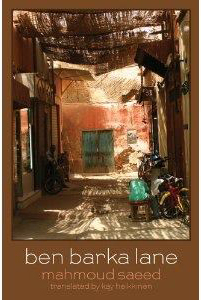By Rebecca Joubin
Ben Barka Lane
By Mahmoud Saeed, translated by Kay Heikkinen
Interlink Books, 2013
“Ben Barka Lane,” written and banned in 1970 in Iraq, but later published in Egypt, Jordan, and Beirut, went on to become one of award-winning Iraqi novelist Mahmoud Saeed’s most powerful novels. It is the story of Sharqi, an Iraqi political refugee, who after 25 years of oppression and political struggle, arrives on Ben Barka Lane in Mohammediya, Morocco. He comes to Morocco in search of a safe haven and finds work as a high-school teacher. Saeed’s colorful visual descriptions make Morocco of the late 1960s come to life for the reader like a vibrant work of art. From the shoe shiner on the ground floor, to the bakery with savory delicacies, to butcher and brasserie, alongside stores selling stamps, lottery tickets, and clusters of pigeons flocking near the walls; Saeed’s melodies, colors, and scents form a magical dance for the reader. Yet with poignant, poetic skill, Saeed illustrates a milieu of contrasts and uncanny calmness. What at first appears to be a paradise, conceals eerie political intrigues in its shadows. The following passage highlights this paradox: “And I was a black mole on the shining face of Mohammediya, a slender stem without branches or roots or leaves, a true stranger, dreaming of happiness and love in unknown lands.” The dreaminess of the above lines is contrasted with what lay underneath the intricacies of the surface: “The melodies ascended in fragments from a wide, peaceful ground, speaking of oppressed groups, powerless, sad, ill and afraid, killed by ignorance and killing each other – groups without number, from the lower strata, dreaming of change, health, hunger satisfied, and smiles.”
Saeed describes with sensitivity the blossoming friendship between Sharqi and Habib, a dissident compelled to remain in Mohammediya as a result of his political activities during the early 60s. The novel revolves around their friendship, which became one of the foundations of Sharqi’s life. After their first meeting, Sharqi describes Habib: “I had never in my life seen anything more beautiful, serene or understanding than his way of looking at one. His eyes drew a loving circle overflowing with truth and affection.” The deep trust and love that develops between them is unshakable until the arrival of Ruqayya, who, for mysterious reasons, works with fervor to breed discord and strife between them. For Sharqi it is love at first sight, and a struggle with his soul as Ruqayya confides that she is in love with Habib. She is forever curious about the personal and most especially the political details of Habib’s daily life, but he forever ignores her. She confides all this in Sharqi, who is torn by feelings of jealousy and love for his companion, Habib. These sentiments gradually turn to animosity and hate for his beloved friend as Ruqayya instigates a series of ambiguous and tragic events that unravel before his eyes. Saeed paints the psychology of the characters, conflicts with their souls, with such mastery that they appear before us in all their loneliness, vulnerability, and compassion. Beautifully translated by Kay Heikkinen, this book is a must read in any undergraduate and graduate level course on Arab literature in translation, as well as courses on Moroccan history and politics, and Iraqi culture in exile.
This article appeared in Al Jadid Magazine, Vol. 18, No. 66, 2012-2013.
Copyright © 2013 AL JADID MAGAZINE

